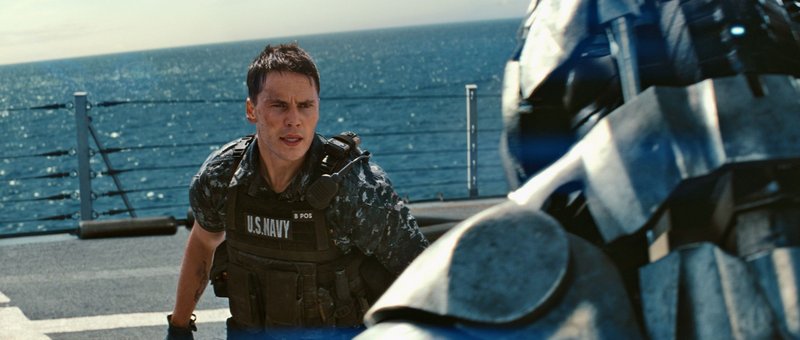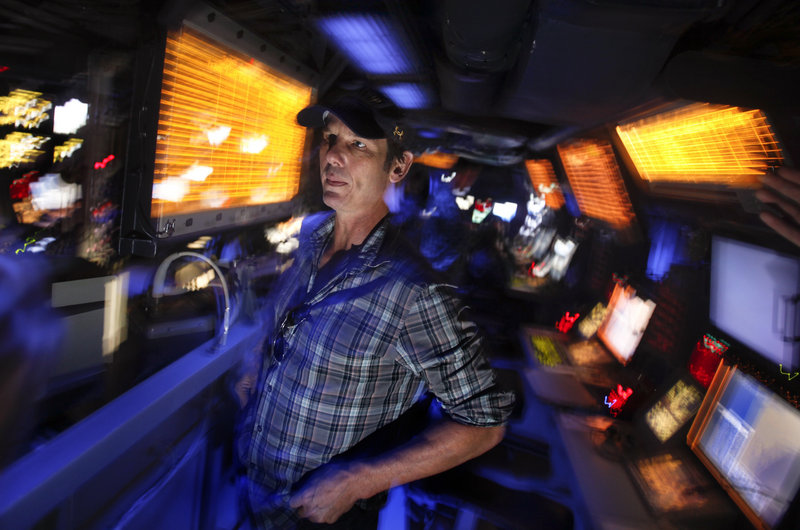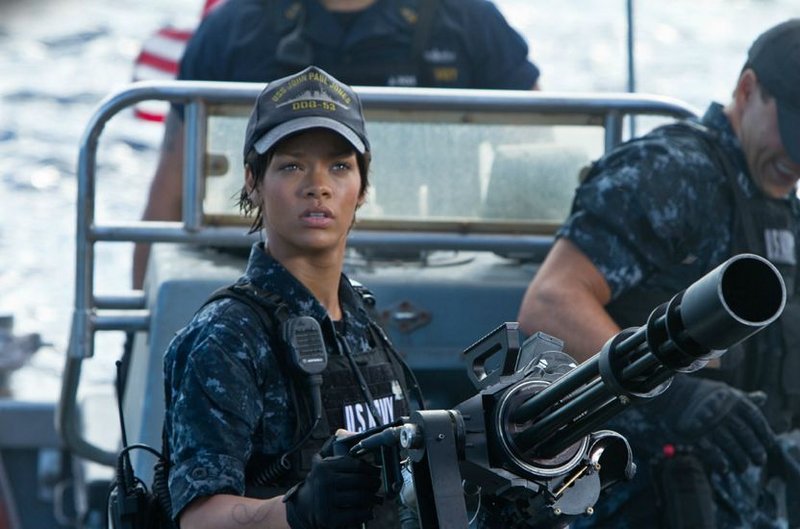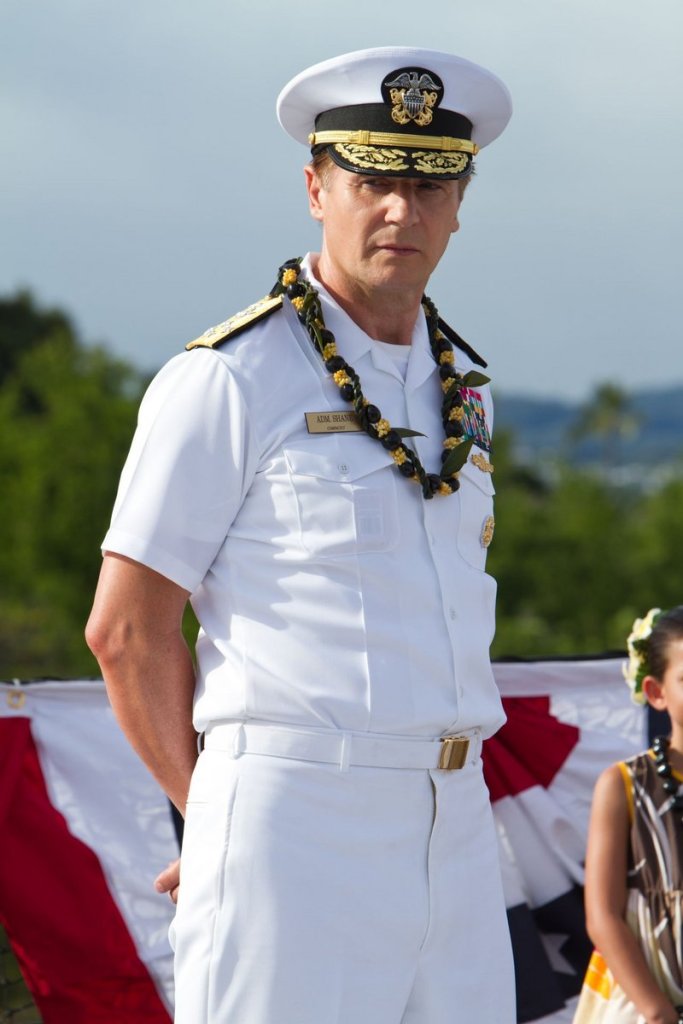ABOARD THE USS SPRUANCE – On a clear, windless morning in January, director Peter Berg climbed from a U.S. Navy helicopter onto the deck of this 9,200-ton destroyer steaming north off the coast of San Diego and hurried to the bridge to meet the ship’s commanding officer, Tate Westbrook.
“I was told you’d know your way around one of these about as well as I do,” Westbrook said to Berg as the director toured the vessel, taking in its torpedo tubes, sonar systems and the compact quarters for 300 sailors.
Berg, 50, has spent a good chunk of his life around the military, first as the son of a Marine who was an avid Naval historian, then while embedded with Navy SEALs in Iraq to research a film and most recently as the director of the naval board game-inspired action movie “Battleship,” which opens in U.S. theaters on Friday.
As any child who has ever sunk an opponent’s plastic submarine can attest, Battleship is a simple, grid-style guessing game, with no narrative arc or characters. But Berg and screenwriter brothers Erich and Jon Hoeber have injected a fleet of story lines and personalities into “Battleship” the movie, in which the Navy becomes embroiled in combat with some mysterious, otherworldly vessels. Earth’s best defense is some very shiny ships and its most attractive people — Taylor Kitsch (of Berg’s long-running TV drama “Friday Night Lights” and the recent box-office dud “John Carter”) plays Alex Hopper, a hotheaded Navy officer; Alexander Skarsgard is Hopper’s better-behaved older brother; and Brooklyn Decker is Hopper’s physical therapist girlfriend, who tends to wounded veterans.
Eager to showcase its ships in front of the taxpayers who pay for them, the U.S. Navy cooperated enthusiastically with the film, providing access to five destroyers and hundreds of real sailors. But with that access came a quandary for Berg: how to shoot a movie starring America’s seaborne military branch without being too American for the foreign filmgoers who typically constitute well over half of an action movie’s audience.
To broaden the movie’s appeal internationally, Berg added regionally specific touches, such as a Japanese naval officer (Tadanobu Asano) and a nod to the Chinese military classic “The Art of War,” as well as elements audiences in nearly every culture seem to enjoy — namely soccer, extraterrestrials and Barbadian pop singer Rihanna firing a giant Gatling gun.
“I did not want ‘Battleship’ to be perceived as an American war film,” said Berg. “I wanted to do everything I could to make the film accessible to a global audience. It felt like bringing an alien component to the film would help take the American jingoism out of it and let it be something that felt more summer-ish and more adventurous.”
IMMERSED IN NAVY LORE
Berg’s background positioned him well to walk the line between portraying the Navy authentically and pleasing Universal Pictures, the studio that financed the $211-million action film with an eye toward building a franchise.
Growing up in New York City, Berg was a captive participant in his father’s maritime hobby, dragged along on family trips to Naval museums and sailing excursions. He majored in dramatic arts at Macalester College in St. Paul, Minn., where he roomed with future William Morris Endeavor agent and co-chief executive Ari Emmanuel, who still represents him; both moved to Los Angeles after graduation to start working in Hollywood.
Berg’s career has taken unlikely turns, among TV and film and directing and acting, but the through-line is his hyper-masculine projects, often produced with surprising sensitivity. Catering truck and production assistant gigs eventually yielded to acting roles, which made use of Berg’s athleticism and cocksure attitude — he starred as a G.I. in the 1992 World War II drama “A Midnight Clear,” a drug-dealing ski instructor in “Aspen Extreme” and a hockey-playing doctor on the TV medical drama “Chicago Hope.”
As a writer and director, Berg continued to gravitate toward sports and testosterone, developing “Friday Night Lights,” the 2004 film and the TV show about the high stakes of high school football in Texas, and directing “The Kingdom” in 2007, a thriller about a murder investigation in Saudi Arabia, and “Hancock,” the Will Smith superhero movie, in 2008.
“I somewhere along the way became fascinated with exploring characters who are willing to put themselves into violent situations, whether it’s football, hockey, boxing, being a cop, being a soldier,” Berg said. “There’s not a lot of people who are willing to put themselves into those situations, and I’m inspired by people who do. It’s not about who’s the toughest physically, it’s about who’s willing to last. I have a fire inside for that. I haven’t found at this point in my life something that inspires me more. Maybe in five years it’ll be a romantic comedy.”
Berg’s next film after “Hancock” was to be an even more adrenalized subject — an adaptation of “Lone Survivor,” a harrowing 2007 memoir by Navy SEAL Marcus Luttrell, the only member of his team to survive a 2005 ambush in Afghanistan. As research for the project, Berg embedded for a month with Navy SEALs in western Iraq — where he said he witnessed another deadly operation — and conducted dozens of interviews with SEALs and their families.
“Some people live and breathe Hollywood and hate to leave it,” said Berg’s producing partner Sarah Aubrey. “Pete is the opposite. He’s a genuinely curious person about things outside of our business. He approaches any group, whether it’s the Navy or a group of high school football coaches who are at the top of their game, with this open, honest enthusiasm and he listens a lot.”
“Lone Survivor” didn’t look like a crowd pleaser in 2009 — war-on-terrorism movies, including Berg’s own “The Kingdom,” had largely disappointed at the box office — and Universal asked Berg to first take on a project with more obvious commercial potential, “Battleship.” (Though it’s centered on the Navy and features many real-life veterans, “Battleship” makes no reference to the U.S. military’s recent wars in Iraq and Afghanistan.)
Following on the other Hasbro toy-inspired film franchises “Transformers” and “G.I. Joe,” the idea of a “Battleship” movie was met early on with some hoots of derision — James Cameron, for one, called relying on board games for stories a sign of Hollywood’s “desperation.” In many ways, however, Berg and his team were starting from scratch with this intellectual property, with no back story to draw upon. Battleship, first sold as a board game by Milton Bradley in 1967, has evolved into computer, video and cellphone app variations but remains essentially a guessing game.
“The game is so simple and so random,” Berg said. “It was a creative balance to try to figure out how can we reference the game in a way that answers some of our critics a bit.”
Berg met with a game psychiatrist about Battleship’s appeal for players, learning that much of it came from the way opponents slowly reveal themselves to each other.
“You don’t know who I am, I don’t know who you are and through the course of the game we discover each other,” Berg said. “There’s something addictive that happens when you find me. The next hook is, as soon as you find me, your goal is to kill me as brutally and ruthlessly and as quickly as possible.”
To duplicate the blind reveal element of the game, Berg added a plot line in which the Navy loses its traditional tracking methods of radar and sonar and must rely instead on tsunami detection buoys — equipped with beacons and positioned in a grid-like fashion — to find the enemy ships.
Another early puzzle was how to incorporate an actual battleship into the film — the modern Navy no longer relies on battleships to slug it out on the open ocean, instead deploying the smaller destroyers to protect its aircraft carriers. By a twist of luck, the USS Missouri, which is permanently docked in Pearl Harbor as a museum, was to be moved for repairs and Berg would have an opportunity to film it on the open sea in early 2010. The filmmakers crafted a third-act battle sequence that would require the old ship and cast Navy veterans in Hawaii — some in their 90s — to help save the world.
Send questions/comments to the editors.






Success. Please wait for the page to reload. If the page does not reload within 5 seconds, please refresh the page.
Enter your email and password to access comments.
Hi, to comment on stories you must . This profile is in addition to your subscription and website login.
Already have a commenting profile? .
Invalid username/password.
Please check your email to confirm and complete your registration.
Only subscribers are eligible to post comments. Please subscribe or login first for digital access. Here’s why.
Use the form below to reset your password. When you've submitted your account email, we will send an email with a reset code.